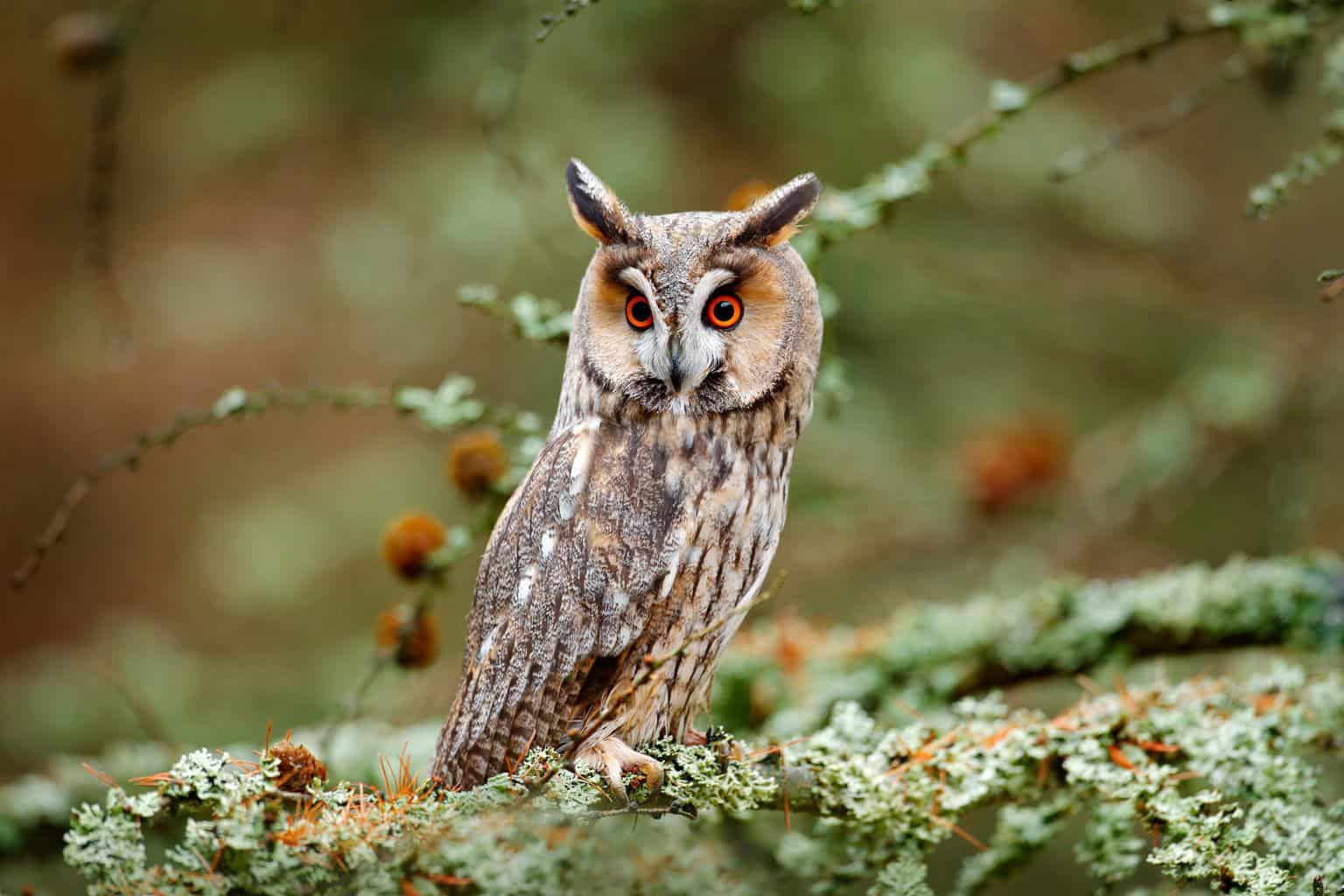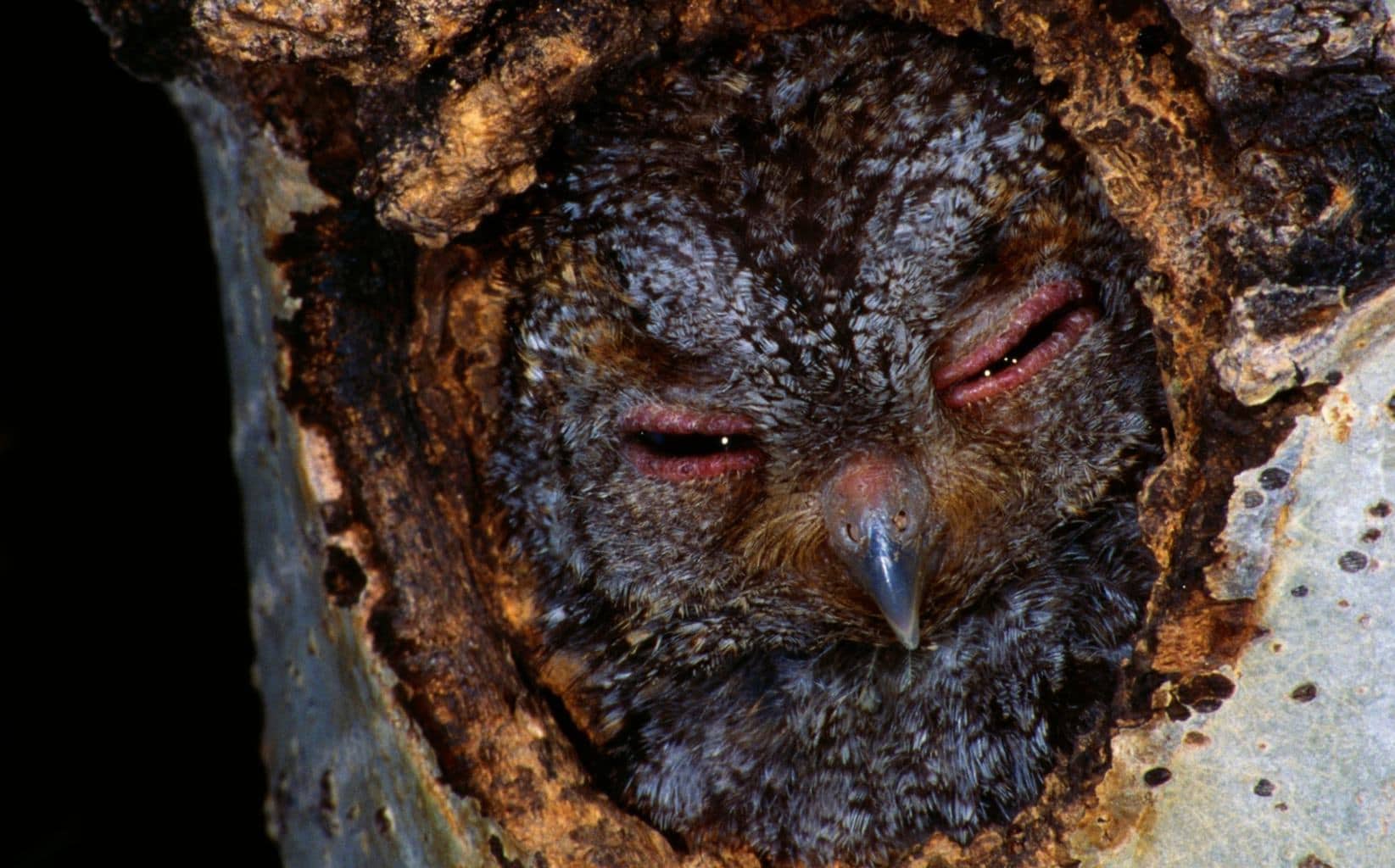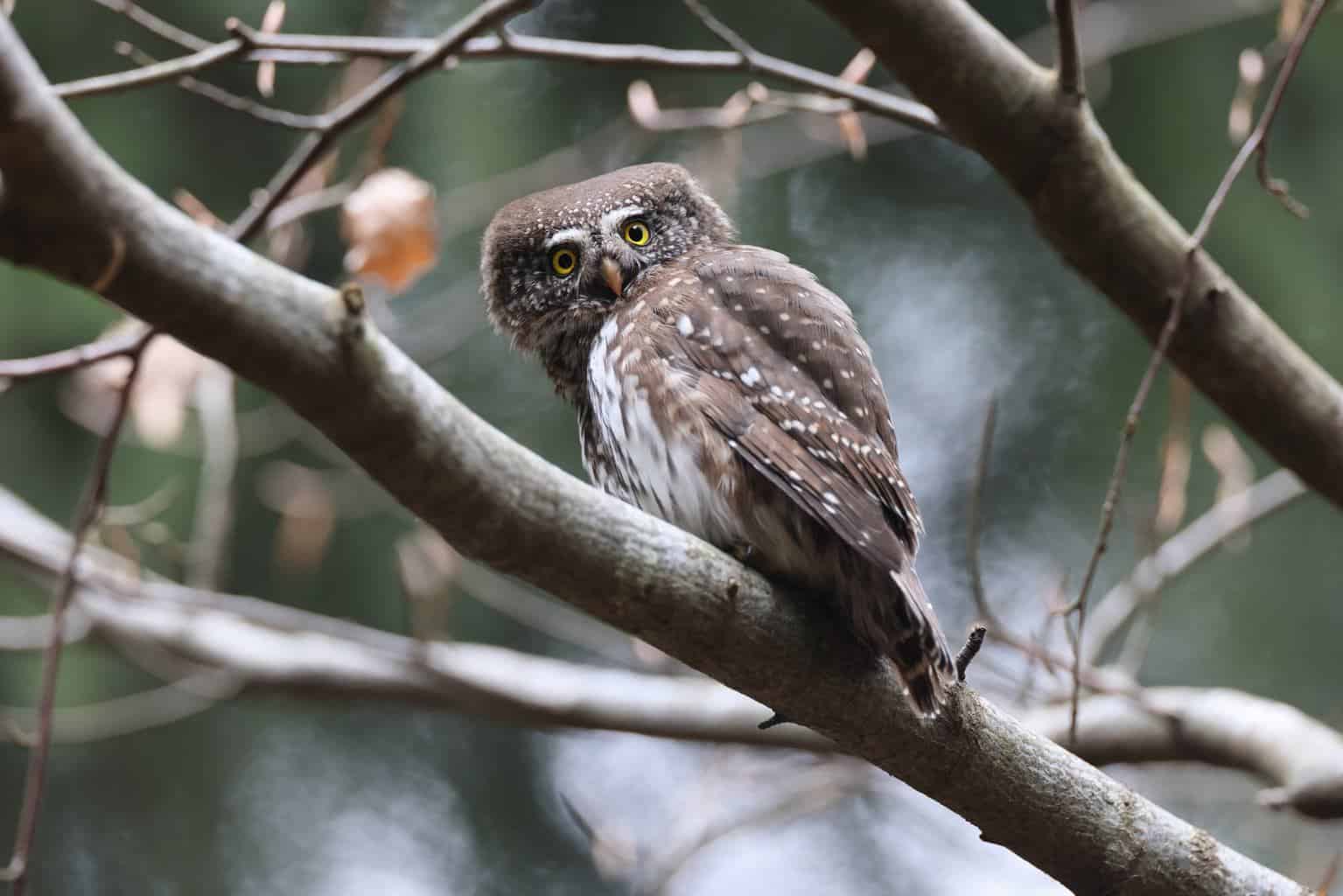Wyoming is well-known for its national parks. The state’s seven national parks—especially Yellowstone—draw in millions of tourists from all over North America every year. Additionally, as you explore the nearly 63 million acres of Wyoming, you might spot something else the state is known for; owls.
There are a total of 13 owl species that reside in Wyoming. We’ve compiled a list of all the owls in the cowboy state so that you can quickly identify any owl you come across. Let’s dive right in!
Northern Saw-Whet Owl

- Scientific Name: Aegolius acadicus
- Length: 7–9 inches
- Weight: 4 ounces
- Wingspan: 16.5-18.9 inches
The Northern Saw-whet owl is known for its big, round head, wide orange eyes, and small body. This small body makes them susceptible to attack by predators, such as the Great Horned owl.
Brown feathers cover their wings and back, contrasting with the white feathers on the owls’ underbellies.
This species has a lifespan of seven years. Small birds, young squirrels, voles, and shrews are the main parts of its diet.
These owls are year-round residents of Wyoming. They inhabit dense forests, especially during mating seasons when the foliage helps hide their nests, which the female Northern Saw-whet owl keeps very neat.
Great Horned Owl

- Scientific Name: Bubo virginianus
- Length: 17-25 inches
- Weight: 49–55 ounces
- Wingspan: Approximately 55 inches
Another full-time resident that can be found all over Wyoming is the Great Horned owl. It feeds on smaller prey, including squirrels, rabbits, skunks, and other owls like the Northern Saw-whet owl mentioned above.
The Great Horned owl inhabits mainly coniferous forests and mixed woodlands. However, this owl is extremely habitat-adaptable. This adaptability enables it to inhabit any area with trees and rocky nesting sites.
They don’t have horns, but rather long pointed ear tufts. They earned their name due to the appearance of their silhouetted ears.
The Great Horned owl is most active in the early winter. It’s known for its territorial behavior; if a fox or human comes too close, it’ll vigorously hoot or dive to protect its territory and eggs.
Barn Owl

- Scientific Name: Tyto furcata
- Length: 12.6–15.7 inches
- Weight: 15–22 ounces
- Wingspan: 39.4-49.2 inches
Barn owls are easy to recognize due to their unique features and distinct hooting. They have a life expectancy of four years. Their feathers are a pale brown color with buff tips. Additionally, their underbellies are covered in white feathers.
This species is an efficient hunter. It’s even capable of catching prey (mice, shrews, and voles) in complete darkness.
Barn owls permanently reside in Wyoming and are commonly found in open grassland areas. They usually nest in hollow trees, areas with a lot of dense foliage, or abandoned buildings.
If you want to spot one, you’ll have a better chance of success during mating season (between March and April).
Short-Eared Owl

- Scientific Name: Asio flammeus
- Length: 13–17 inches
- Weight: 7.3–17 ounces
- Wingspan: 33.5-40.5 inches
Short-eared owls live up to their name. They have extremely small ear tufts that can be difficult to see. They also have brown feathers with buff spots.
These owls have a life expectancy of 4–12 years. Voles, mice, and squirrels make up the majority of their diet.
They’re full-time residents of Wyoming, and they nest in open grasslands. Unusually, they’re active day and night. Mornings are dedicated to courting rituals, and the night is reserved for hunting.
Long-Eared Owl

- Scientific Name: Asio otus
- Length: 14–16 inches
- Weight: 9 ounces
- Wingspan: 35.4-39.4 inches
Also known as the Northern Long-eared owl, this species’ long, horn-like tufts make them easy to identify. Their stout bodies are covered in dark feathers, which contrast with their orange faces. They’re year-round residents of Wyoming.
Long-eared owls live in large colonies that are made up of a breeding population of hundreds of owls! This number decreases slightly as the owls move away for the mating season. However, they roost within 50 feet of each other.
Their natural habitat consists of open grasslands and coniferous woodlands.
This bird of prey lives for about 4–10 years. They usually eat small mammals, deer mice, rats, and rabbits. These owls have an unusual way of consuming their prey; they swallow it whole instead of cutting it into parts as other owls do.
If bird watchers follow the sound of its hooting, they should be able to find the owl easily.
Eastern Screech Owl

- Scientific Name: Megascops asio
- Length: 6–10 inches
- Weight: 4.2–8.6 ounces
- Wingspan: 18.9-24.0 inches
The Eastern Screech-owl‘s unique grey feather pattern and sharp ear tufts make it easy to identify. Even though it has a nearly two-foot wingspan, it is very light and ranges in weight from four to 8 ounces.
These owls have a life expectancy of 14 years. They prey on rats, squirrels, rabbits, and skunks. Despite usually inhabiting areas where the trees are dense, these owls are capable of nesting and breeding in suburban areas.
The Great Horned owl hunts Eastern Screech-owls. Therefore, they usually avoid areas inhabited by this predator.
The species is a permanent resident of Wyoming. However, it sticks to a few areas in the far north and southeast of the state.
Western Screech Owl

- Scientific Name: Megascops kennicottii
- Length: 7.5–9.8 inches
- Weight: 3.5–10.8 ounces
- Wingspan: 21.6–24.4 inches
The Western Screech-owl is pretty uncommon in Wyoming. Range maps show the birds reaching almost all the way to Central America. However, it can only be found in the West and North of Wyoming. This owl isn’t a picky eater. It eats anything from worms and crayfish to rats and bats.
Western Screeches are powerful predators despite their small size. They’re capable of hunting larger prey, including cottontail rabbits.
They’re beloved by locals because they’ve grown used to human presence. They frequently nest in urban parks, residential areas, and can even be found in backyard boxes.
Snowy Owl

- Scientific Name: Bubo scandiacus
- Length: 20.5-27.9 inches
- Weight: 70.5 ounces
- Wingspan: 49.6-57.1 inches
These owls have a snow-like appearance due to their white feathers. This feature is vital for their survival because the owls naturally inhabit the tundra region.
They have a life expectancy of ten years, and they feast on other birds, rabbits, fish, and rodents.
It’s important to note that the Snowy owl may dive at anything that wanders too close to its nesting area. If you see a Snowy owl, be cautious! Their loud, booming hoot is another method for deterring predators.
The Snowy owl’s irruptive winter range is enormous and they migrate as the season changes. Therefore, these owls are only in Wyoming during the winter when it’s too cold in their usual habitat.
Great Gray Owl

- Scientific Name: Strix nebulosa
- Length: 24.0–33.1 inches
- Weight: 24.7–60.0 ounces
- Wingspan: 53.9–60.2 inches
Despite being the tallest owl in the United States, the Great Gray owl isn’t the heaviest. However, its lack of weight doesn’t hinder its ability to hunt. This amazing bird is extremely strong. It can break through thick ice that can withstand human weight, only to catch small animals.
The owl’s diet consists of 80-90% rodents. Hundreds of mice go to their doom every year at the talons of this mighty hunter. The remainder of its diet is made up of birds like thrush, grouse, and ducks.
These owls have a characteristic “X” shaped mark on their face and their body feathers are fluffy, silvery gray. This makes them easy to identify.
These mysterious birds are elusive and tend to make nests in dead trees. They’re also easily disturbed. So, if you spot one, be careful!
Flammulated Owl

- Scientific name: Psiloscops flammeolus
- Length: 5.9–6.7 inches
- Weight: 1.5–2.2 ounces
- Wingspan: 15.9–16.1 inches
The flammulated owl is a small owl with reddish feathers. It’s only found in a small area in Southern Wyoming during its breeding season. This species breeds in the summer, and it usually feeds on insects.
The owl is commonly spotted in Medicine Bow-Routt National Forest. However, you’ll need to keep your eyes peeled as its small size makes it difficult to spot. It’s also very good at camouflaging.
This owl can scare off predators using its deep, low-pitched hoot. Its hoots at night make it sound like it’s a much larger owl.
Boreal Owl

- Scientific name: Aegolius funereus
- Length: 8.3–11.0 inches
- Weight: 3.3–7.6 ounces
- Wingspan: 21.6–24.4 inches
Boreal Owls are permanent residents of Central and Southeastern Wyoming. They inhabit mixed-wood and coniferous forests.
These owls lack ear tufts and have large square-shaped heads, stocky bodies, and short tails. They prey on small mammals and birds.
Unlike other owls on this list, boreal owls are quiet and don’t frequently hoot except when looking for mates.
Northern Pygmy-Owl

- Scientific name: Glaucidium gnoma
- Length: 6.3–7.1 inches
- Weight: 2.1–2.5 ounces
- Wingspan: 14.5–16 inches
Northern Pygmies are best known for being very small. They inhabit the mountainous areas of Northwestern Wyoming all year. They’re active during the day and hunt by ambushing smaller birds.
Northern Pygmy owls have asymmetrical ears, which give them advanced hearing abilities. They also have dark spots on the back of their heads. These spots look like eyes, which scare off smaller birds that might try to ambush the owl.
Burrowing Owl

- Scientific name: Athene cunicularia
- Length: 7.5–9.8 inches
- Weight: 5.3 ounces
- Wingspan: 21.6 inches
Burrowing owls are found throughout Wyoming during their breeding season. However, they’re unlike other owls since they nest in underground burrows abandoned by prairie dogs.
They also store extra food in their burrows, which makes them even more difficult to spot. The species usually inhabits grasslands and prairies.
Due to their nesting habits, Burrowing owls are difficult to come by. Their prey varies from small mammals to grasshoppers or scorpions.
This owl has long legs, round heads, and bodies covered in brown feathers with white speckles. Like the Boreal owl, they don’t have ear tufts.
Conclusion
In conclusion, owls are only one of the many different species of birds found in Wyoming. Other species found in the state include hawks and woodpeckers.
The state has a total of 13 different owl species, which vary in lifespan, range in diet, nesting area, and size. If you pay close attention, you will be able to distinguish between their different calls. From the double hoot of the Barred owl and quick hoots of the Boreal owl to the barking sound of the Long-eared owl, these common sounds echo across the Wyoming fields at night and entertain for hours.
Birdwatchers should be wary of some species like the Snowy and Barred owl because they can be aggressive. Other than that, you’ll have loads of fun watching the birds!

